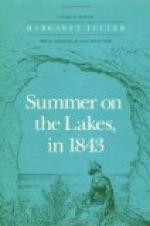Schoolcraft’s Algic Researches is a valuable book, though a worse use could hardly have been made of such fine material. Had the mythological or hunting stones of the Indians been written down exactly as they were received from the lips of the narrators, the collection could not have been surpassed in interest, both for the wild charm they carry with them, and the light they throw on a peculiar modification of life and mind. As it is, though the incidents have an air of originality and pertinence to the occasion, that gives us confidence that they have not been altered, the phraseology in which they were expressed has been entirely set aside, and the flimsy graces, common to the style of annuals and souvenirs, substituted for the Spartan brevity and sinewy grasp of Indian speech. We can just guess what might have been there, as we can detect the fine proportions of the Brave whom the bad taste of some white patron has arranged in frock-coat, hat, and pantaloons.
The few stories Mrs. Jameson wrote out, though to these also a sentimental air has been given, offend much less in that way than is common in this book. What would we give for a completely faithful version of some among them. Yet with all these drawbacks we cannot doubt from internal evidence that they truly ascribe to the Indian a delicacy of sentiment and of fancy that justifies Cooper in such inventions as his Uncas. It is a white man’s view of a savage hero, who would be far finer in his natural proportions; still, through a masquerade figure, it implies the truth.
Irving’s books I also read, some for the first, some for the second time, with increased interest, now that I was to meet such people as he received his materials from. Though the books are pleasing from their grace and luminous arrangement, yet, with the exception of the Tour to the Prairies, they have a stereotype, second-hand air. They lack the breath, the glow, the charming minute traits of living presence. His scenery is only fit to be glanced at from dioramic distance; his Indians are academic figures only. He would have made the best of pictures, if he could have used his own eyes for studies and sketches; as it is, his success is wonderful, but inadequate.
McKenney’s Tour to the Lakes is the dullest of books, yet faithful and quiet, and gives some facts not to be met with elsewhere.
I also read a collection of Indian anecdotes and speeches, the worst compiled and arranged book possible, yet not without clues of some value. All these books I read in anticipation of a canoe-voyage on Lake Superior as far as the Pictured Rocks, and, though I was afterwards compelled to give up this project, they aided me in judging of what I afterwards saw and heard of the Indians.
In Chicago I first saw the beautiful prairie flowers. They were in their glory the first ten days we were there—
“The golden and the flame-like flowers.”
The flame-like flower I was taught afterwards, by an Indian girl, to call “Wickapee;” and she told me, too, that its splendors had a useful side, for it was used by the Indians as a remedy for an illness to which they were subject.




